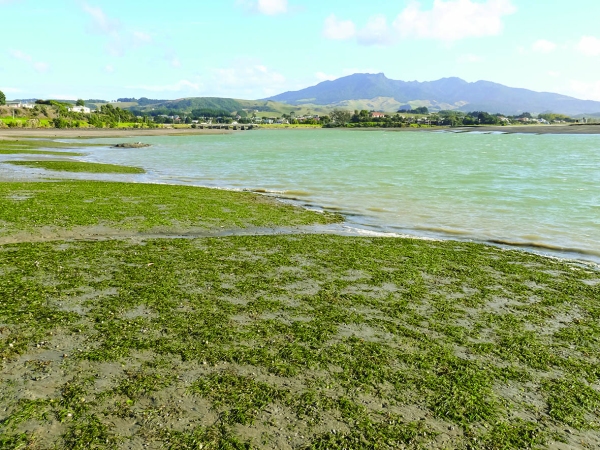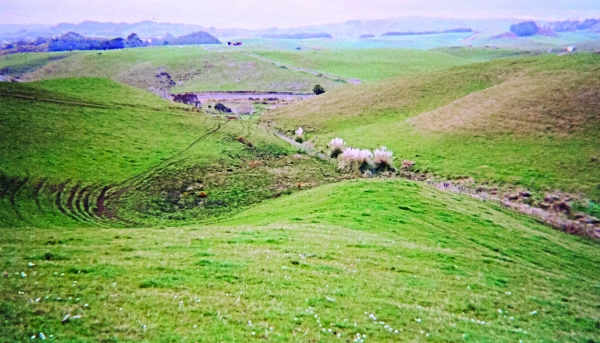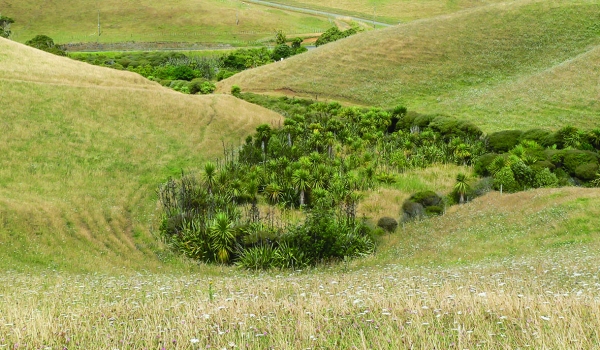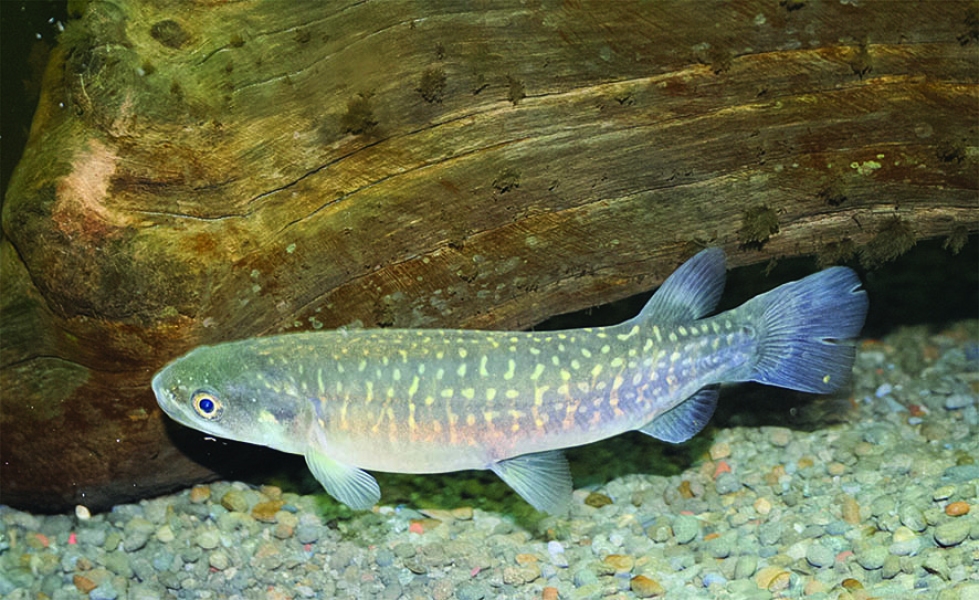Our streams, rivers and lakes should be home to over 40 native species of freshwater fish and hundreds of plant life species and invertebrates – many found only in New Zealand. Where are they?
Crouch along the banks of healthy New Zealand waterways and you can almost hear the hum of life. Beneath the canopy of native trees, insects flit across the ruffled water and crawl across stones. Fish flick through the current, or hide in the eddies.
Regional council macroinvertebrate index monitoring at over 1000 sites over recent years suggests that about 39 per cent of these streams have been moderately to severely degraded by human activities (see graph at the bottom of this page). Consequently, there will be many varieties of fish, plant and insect life missing from them – pushed further back into the remaining safe habitats.
However, many streams running through urban, industrial and farm land are being rehabilitated as humans replant stream banks and staunch the flow of sediments and nutrients.
As water returns to normal, it may be swimmable for people, but it can also remain lacking in sensitive species. Scientists are discovering that there are two other factors critical to encouraging sensitive life to return to restored streams: the ability of species to reach newly rehabilitated areas in sufficient numbers to establish populations in the face of competition with resident ‘tolerant’ species, and a wide variety in habitats within the stream.
In the North Island, for example, a study of nine streams flowing through 0.2km to 4.2km long areas of planted or regenerating riparian forest established 13 to 35 years previously have not seen an increase in sensitive invertebrate stream life. Critical to that result was the fact that areas upstream had not been riparian planted, meaning that the restored areas were really just small islands of good habitat in a stream of poor habitat. In contrast, hill farm streams in catchments adjacent to native forest, where riparian restoration has occurred from the headwaters downstream, have shown shifts towards dominance by sensitive species within a decade.
According to Dr Richard Storey, a freshwater ecologist with NIWA, expectations of life returning to cleaned streams must be tempered by the reality of the wider environment.
“There are a lot more factors involved in restoring life to a stream than water quality. The stream’s surroundings, and conditions upstream, are critical.
“There are so many variables involved that the speed and pattern of restoration of species to restored streams is a little bit unpredictable.
“That’s not to say removing sediment, heat and nutrient overload from streams does not result in sensitive stream life returning. It does happen. Tools like riparian management can produce an increase in life-related monitoring indexes over time.
“At the moment we can’t be sure of how soon they return, or which species will return,” Storey says.
Restoration of life to streams is dependent on sources of colonists.
“Sensitive fish, insects and plants need to come from somewhere else. Often that is national parks, reserves and other forested areas. The closer the cleaned areas are to existing colonies, the more likely they are to be colonised,” Storey says.
A NIWA study of streams close to Egmont National Park found that riparian protection leads to an increase in ‘EPT richness’. EPT refers to the number of species belonging to three large ‘orders’ (groups) of aquatic insects – commonly called mayflies, stoneflies and caddisflies.
“These insects are generally quite sensitive to habitat and water quality, so a greater number of species present means that habitat and water quality must be improving,” Storey says.
Ironically, the streams closer to the National Park showed less improvement than those further away. The scientists suspect the Park was already providing colonists before restoration occurred, so there was less room for improvement.
NIWA is attempting to bridge a gap in knowledge about the dispersal capabilities of insects and fish.
“We are unsure how far each species is capable of reaching, and the order in which each species colonises. If a degraded habitat is dominated by a few ‘tough’ species, then those could prevent others coming in after it has been restored.”
A NIWA study in Hawke’s Bay is using intermittent streams, those that regularly dry up, to discover how far colonists from nearby perennial streams can reach when the streams start flowing again. In a related study, genetic differences between populations allow scientists to map where the colonists have come from.
“These studies will help tailor restoration efforts to fit what life does naturally,” Storey says.
Work by NIWA’s freshwater team is confirming the importance of particular habitat features in the restoration of stream life, as well as clean water.
“One habitat feature we think may be important is emergent rocks – those with their top out of the water. Insects can land on these and crawl underwater to lay their eggs.
“We find rocks like these usually covered with insect eggs, and we suspect they may be critical for some insect species to complete their lifecycle. If they are absent, then those species can never really establish a self-sustaining population at that site.”
Natural vegetation cover is critical. The riparian vegetation needs to shade the stream to keep the water temperature low enough for some sensitive native species, and to prevent sunlight fuelling over-growth of aquatic plants and algae. Aquatic plant life is important as a food source and hiding place for insects and fish, but too much growth clogs the stream and forces them out. Riparian vegetation cover also drops wood and leaves into the streams, providing more food, but critically, giving more variability to the stream flow – and thus more habitats.
Fallen logs and branches cause changes in water flow, where water trickles, riffles and tumbles over and around the material. This creates habitat and refuges where invertebrates and fish can crawl, graze and hide.
NIWA has trialled large wood additions to pasture streams at Whatawhata, Waikato. The work by Aslan Wright-Stow, John Quinn and Paul Franklin indicates that the additions to headwater streams (2–3m wide channels in 300ha catchments) enhances physical habitat diversity.
The scientists added treefern logs in a combination of sill-log dams (logs laid horizontal) and angled flow deflectors. The structures remained in place through an annual cycle of storm flows with little maintenance.
Surveys six weeks and one year after wood addition show that native fish and koura were using the structures.
The study demonstrates how relatively inexpensive and small-scale changes can make immediate improvements for aquatic life. But large-scale changes are still necessary to coax the native species out of our pristine or slightly impaired streams and into colonising restored streams.
As scientists learn more about what it takes for life to move back into clean streams, those restoring the streams stand a better chance of ending up with more than a clean but barren waterway.
Stream life
The biggest family of native freshwater fish are the galaxiids, named after their stunning spotted patterns that resemble starry galaxies. The most well-known galaxiid is īnanga (the most numerous whitebait of the five species) which, like most New Zealand native freshwater fish, has a lifecycle that begins as an egg sheltered by streamside vegetation, until they’re swept out to sea before returning to the fresh water as juveniles.
Streams, rivers and estuaries not only provide transport for migratory fish, but they are also critical in moving nutrients and providing drainage for the landscape. Leaves and organic material are processed by moving water into fine particles which provide food for organisms downstream like caddisflies and freshwater shrimps.
Where water tumbles over clean pebbles, some caddisflies build their own protective houses out of rocks, sticks and sand. Whole, purpose-built communities of insects interact under the water’s surface. Caddisflies, along with other macroinvertebrates (meaning they have no backbones and can be seen without a magnifying glass or microscope) are often used as an indicator of water quality. In a good, healthy stream you’re likely to find dozens of different types within just one square metre of streambed. They enjoy the shelter of overhanging plants that would have lined most New Zealand waterways before human settlement.
Giant kōkopu, floating ferns, giant dragonflies and aquatic plants bunch near the banks, providing shelter and habitat.
Aside from providing food and shelter, streamside plants can also regulate water temperature, making the stream more hospitable to fish and insects while minimising the risk of choking algae blooms. They can also provide a buffer along the stream banks that filters harmful sediment and nutrients and also protects the bank from erosion during floods.
As an ecosystem, the plants, insects and fish of New Zealand’s waterways are heavily co-dependent, but are also surprisingly resilient. With proper management of riparian areas and strategies to reduce pollution from industrial, residential and farm runoff, our rivers and streams can be abundant with life.
What’s good about streams?
There’s human benefit from rehabilitated streams.
Whaingaroa Harbour Care has spent close to two decades voluntarily planting native plants and fencing along riparian strips of farms around Raglan.
The organisation’s leading light, Fred Lichtwark, says that fencing and planting is “a vital component of good farm management”.
He says the 40 farms that have participated in the scheme have experienced fewer stock losses and better stock health. No longer are cows dying in boggy streams, getting sick from drinking water polluted by their own faeces, or stressed by lack of shade and shelter.
Farmers have also been able to increase the amount of stock on their farms thanks to better pasture quality.
Lichtwark says less sediment and nutrient runoff has dramatically cleaned water in the harbour. The improved habitat has led to the return of flounder, whitebait and other marine life. He cites, for example, the return to sea grass, which is acting as a snapper nursery.
The job isn’t finished though. Along with more work on farms, Fred has his eyes set on the pollution coming from urban environments: “Urban development has some pretty negative impacts on the harbour as well.”
Before and after images of Whaigaroa Harbour. [Fred Lichwark]
Thirty-nine per cent of monitored New Zealand streams have streambed life that indicates ‘moderate or severe degradation’
Data collected by regional councils on river bed invertebrates throughout the country suggest that 39 per cent of the monitored streams have been degraded in some way by human activity. These sites are biased towards pasture catchments (55 per cent more sites than would occur if chosen randomly).
Macroinvertebrate Community Index (MCI) scores calculated from streams sampled around New Zealand can be used to deduce the state of the water. Invertebrates are sensitive to water quality, so their presence can indicate stream health.
Based on the types and sensitivity of macroinvertebrate life found, Aslan Wright-Stow, a freshwater ecologist with NIWA, calculated that 22 per cent of the streams regularly surveyed by regional councils have clean water, and 39 per cent have been mildly impacted (sensitive species are usually sustainable and it is difficult to directly attribute human influence). Thirty-nine per cent of streams have been moderately (sensitive species are less frequent than tolerant species) or severely degraded (sensitive species are generally not present).
The data use the sensitivity (to organic enrichment) of invertebrates as a means of assessing water quality. The data were sourced from State of the Environment monitoring (regional council data for wadeable streams) published by the Ministry for the Environment and represent five-year median MCI values from a total of 1008 stream reaches (there may be more than one reach per stream). It is an indicator and does not measure drinking water quality. The estimate is based on data from sites sampled predominantly from pasture locations (68 per cent). So clean water environments are likely to account for a greater proportion of streams than indicated in these monitoring results.
|
Clean water |
Mild impact |
Moderate impact |
Severe impact |
||
|
% of NZ streams (in MfE's online database) |
22 |
39 |
27 |
12 |
|









